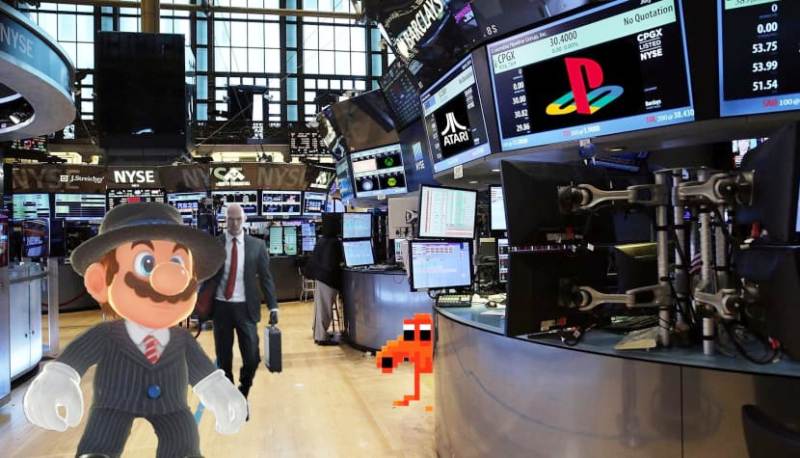Over the years, there have been significant changes in the video game industry. So let’s check out everything about the Video Game Price Chart article. One thing has always been a hot topic in video games, from their humble beginnings with Pong and Atari to the highly sophisticated, graphically intensive games we see today. The goal of this Video Game Price Chart article is to give readers a clear understanding of the trends in Video Game Price Chart.
🎮💸 The world of video gaming is full of mysteries, none more intriguing than their Video Game Price Chart, from the nostalgic cartridges of the 1980s to today’s ground-breaking digital realms. Have you ever wondered why some books are expensive while others are a deal? Or why do Video Game Price Chart differ so drastically between countries?
Even the most ardent gamers might miss some of the revelations if you dive into this comprehensive Video Game Price Chart guide to video game pricing. Hold on tight because we’re about to enter the economic roller coaster that is the world of video games. Your wallet will start to shake and your joystick will start to tremble. Now let’s get to know more about this Video Game Price Chart guide.
Historical Perspective: A Brief Overview
The 1970s – 1980s
- Cartridge-Based Games: Ranged from $20-$50.
- Popular Consoles: Atari 2600, ColecoVision.
- Notable Mention: The Legend of Zelda (NES) sold at $50 in 1987.
The 1990s
- Cartridge-Based Games: Ranged from $40-$70.
- CD-ROM Games: Ranged from $30-$50.
- Popular Consoles: SNES, Sega Genesis, PlayStation.
- Notable Mention: Final Fantasy VII (PS1) launched at $49.99 in 1997.
The 2000s
- CD/DVD-ROM Games: Ranged from $40-$60.
- Popular Consoles: PlayStation 2, Xbox, Nintendo GameCube.
- Notable Mention: Halo 2 (Xbox) retailed at $49.99 in 2004.
The 2010s
- Blu-ray/Digital Games: Ranged from $60-$70 for AAA titles.
- Popular Consoles: PlayStation 4, Xbox One, Nintendo Switch.
- Notable Mention: The Witcher 3 (PS4) launched at $59.99 in 2015.
The 2020s and Beyond
- Digital/Physical Games: Starting to see a range from $60-$70 for AAA titles with deluxe versions hitting upwards of $100.
- Popular Consoles: PlayStation 5, Xbox Series X|S.
- Notable Mention: Demon’s Souls Remake (PS5) launched at $69.99 in 2020.
Factors Influencing Video Game Price Chart
The following variables affect how much video games cost:
- Development Costs: As technology advances, the cost to produce games rises.
- Licensing: Games that use licensed content (like sports games with real teams and players) often come with additional costs.
- Marketing and Distribution: High-profile releases often have large advertising campaigns.
- Platform: Games on newer consoles tend to be priced higher.
- Editions and Extras: Special editions, which might include extra content or physical goodies, can significantly raise the Video Game Price Chart.
Emerging Trends
- Subscription Services: Xbox Game Pass, PlayStation Now, and EA Play offer access to multiple games for a monthly fee.
- Free-to-Play Models: Games like Fortnite and Apex Legends are free to play but generate revenue through in-game purchases.
- Digital Sales: With the growth of digital marketplaces, games are often available at discounted Video Game Price Chart during sales events.
Video Game Price Chart: A Snapshot
| Era | Average Price Range | Popular Game at Launch Price |
|---|---|---|
| 1970s-1980s | $20-$50 | The Legend of Zelda – $50 |
| 1990s | $30-$70 | Final Fantasy VII – $49.99 |
| 2000s | $40-$60 | Halo 2 – $49.99 |
| 2010s | $60-$70 | The Witcher 3 – $59.99 |
| 2020s | $60-$100+ | Demon’s Souls Remake – $69.99 |
The Impact of Digital Distribution
The emergence of digital distribution over the past ten years has significantly altered how video games are purchased, offered for sale, and used. This is how:
Benefits of Digital Distribution
- Instant Access: Once purchased, players can download and start playing games without the wait for physical delivery.
- Sales and Discounts: Digital platforms like Steam, PlayStation Network, and the Xbox Store often feature sales, allowing gamers to get games at significant discounts.
- No Physical Storage: Without the need for physical discs, gamers save space and reduce clutter.
- Eco-Friendly: The elimination of packaging and the physical production process is a greener alternative.
Challenges with Digital Distribution
- No Resale Value: Unlike physical copies, which can be sold or traded, digital games are tied to an account and cannot be resold.
- Digital Rights Management (DRM): Some gamers raise concerns about ownership when games are tied to online platforms.
- Storage Limitations: As games increase in size, hard drive space on consoles and PCs can be a limitation, leading to the need for additional storage solutions.
The Role of Microtransactions and DLCs
In the gaming industry, the use of microtransactions and DLCs (downloadable content) has significantly increased over the past ten years.
- Microtransactions: These are small in-game purchases, often cosmetic, which can range from character outfits to weapon skins.
- Pros: Allows players to customize their experience and developers to continue generating revenue from a game post-launch.
- Cons: Controversies arise when microtransactions give gameplay advantages, leading to a “pay-to-win” scenario.
- DLCs: Additional content that players can purchase post-launch to extend the life of a game.
- Pros: Provides players with more content and can revive interest in an older game.
- Cons: Some gamers believe that developers withhold content to sell it later as DLC, rather than including it in the base game.
Indie Games: Changing the Pricing Narrative
Without the support of major publishers, independent (or “indie”) game developers have had a big impact on Video Game Price Chart:
- Pricing Freedom: Indie devs have more flexibility in pricing their games, often leading to more affordable titles.
- Unique Experiences: Many indie games offer unique, artistic experiences that stand out from mainstream titles, making them highly valuable despite often having a lower price point.
- Bundled Deals: Platforms like Humble Bundle offer collections of indie games at “pay-what-you-want” prices, providing incredible value for gamers.
Looking Ahead: The Future of Game Pricing
Even though foreseeing the future is never easy, the following trends seem likely:
- Mixed Pricing Models: As game development costs rise, developers might mix traditional upfront pricing with in-game monetization.
- Dynamic Pricing: Using algorithms, the Video Game Price Chart may adjust based on demand, player behaviour, and other factors.
- Crowdfunding and Early Access: Developers might continue to seek funds directly from their audience, offering early access to games as an incentive.
Regional Variations in Game Pricing
The substantial regional variation in the Video Game Price Chart is one factor that is frequently disregarded when talking about it. Here is more information on this feature:
Currency Fluctuations and Purchasing Power
- Exchange Rates: Even if a game is priced at $60 in the U.S., that doesn’t necessarily mean it’ll translate directly into another country’s currency at the current exchange rate.
- Economic Factors: In countries with a lower GDP per capita, prices might be adjusted to be more in line with the average purchasing power of the citizens. Conversely, in countries with high VAT (Value Added Tax) rates or import duties, games can become more expensive.
Localization Costs
- Translation and Dubbing: Games that are translated or dubbed into various languages can sometimes bear additional costs. This effort ensures the game is accessible and enjoyable to a broader audience but may affect the final Video Game Price Chart.
- Cultural Adjustments: In some cases, games need adjustments or modifications to fit within the cultural context or adhere to local regulations. These adaptations, again, can influence the pricing structure.
Streaming and Cloud Gaming: A New Frontier
The conventional model of purchasing games is undergoing further disruption thanks to services like Google Stadia, NVIDIA GeForce Now, and Xbox Cloud Gaming.
- Subscription-Based Access: Much like Netflix for movies, these services allow gamers to access a library of games for a monthly fee, bypassing the need to buy individual titles.
- Hardware Savings: Cloud gaming platforms negate the need for high-end gaming hardware since the games run on powerful servers and stream to the user’s device.
Potential Implications for Game Prices
- Decreased Emphasis on Ownership: As more players shift towards streaming platforms, the idea of “owning” a game might become less critical.
- Volume Over Price: Developers might prioritize getting their games onto these platforms for exposure, possibly accepting a lower per-game revenue in exchange for volume.
Community and Player Engagement: Beyond the Price Tag
Last but not least, the cost of a game isn’t the only consideration in today’s gaming market. The longevity of games has come to depend heavily on the gaming community and ongoing player engagement.
- Regular Updates and Events: Games like ‘Fortnite’ and ‘Overwatch host regular in-game events and updates to keep the player base engaged, driving in-game purchases and maintaining consistent player numbers.
- Community Feedback: Developers are increasingly turning to their communities for feedback, using platforms like Discord or in-game surveys. Engaged players are more likely to invest in a game, both time and money.
Conclusion
So this is all about the Video Game Price Chart article guide. Pricing for video games is a complicated issue that is influenced by several variables, including production costs and the platform of release. While the aforementioned graph offers a general overview, it’s important to keep in mind that game costs can change depending on region, special editions, and other elements. It’s intriguing to speculate about how the Video Game Price Chart will change in the future as the industry develops. Will the average cost of AAA titles continue to increase, or will subscription-based models take over as the standard? Time will only tell.
Hope you like this Video Game Price Chart from here now. How video games are priced also changes as the industry develops. The way we buy and value games is constantly changing, thanks to factors like the growth of digital distribution and the rising significance of independent developers. To ensure they get value and enjoyment from their gaming experiences, players must stay informed and weigh the advantages and disadvantages of various purchasing options. Hope you enjoy checking this type of Video Game Price Chart content.
The complex world of Video Game Price Chart reflects changes in consumer behaviour, technological advancements, cultural influences, and industry evolution. Understanding these subtleties as players enable us to appreciate the value and experiences that games provide. Staying informed and adaptable will ensure that we continue to get the most out of our cherished hobby as the industry morphs and adapts. If you enjoy reading the Video Game Price Chart then please do share the Video Game Price Chart with others as well.
People Also Ask (FAQs)
1. Why do new game releases seem pricier than ever before? 🤔
As technology develops, game development costs increase. Larger teams and longer development cycles are needed to create games with improved graphics, intricate storylines, and challenging game mechanics. But that’s only the tip of the iceberg; read our in-depth guide to learn more about what’s raising prices!
2. Digital vs. Physical: Which one offers more bang for my buck? 💽 vs. ☁️
Does the digital revolution also result in better value for money considering how we access and play games has changed? Explore the advantages and disadvantages of both formats in-depth to help you decide which to use for your upcoming gaming binge.
3. Are microtransactions taking over the gaming world? 💎💰
In-game purchases are commonplace and range from cosmetic upgrades to gameplay boosters. But are they modifying how we play and pay for games fundamentally? Join us as we analyze this contemporary trend and consider what it means for gamers worldwide.
4. How do indie games stack up against AAA titles in terms of value? 🕹️ vs. 🎮
How do independent games stack up against their blockbuster counterparts in terms of value given that they frequently cost less and provide distinctive experiences? Join us as we explore the world of independent gaming to find out!
5. Why do game prices vary so much across different countries? 🌍
Localization, exchange rates, and economic factors are all relevant. Learn why a game might be more expensive or less expensive depending on where you are in the world by unravelling the complexities behind regional game pricing.
6. Is cloud gaming the future, and how will it impact game prices? ☁️🕹️
High-end hardware won’t be required in the future, according to streaming platforms, but what does this mean for the cost of individual games? Join us as we journey into the gaming industry’s hazy future!
Join the conversation and let’s decode the mysteries of Video Game Price Chart together!

















